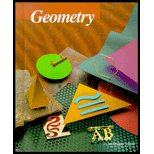
Concept explainers
To enter the program and run it for several times for large values of D like
Explanation of Solution
Given:
Break a stick into three pieces to get the probability that you can join the pieces end-to-end to form a triangle. If the sum of the length of any two pieces is less than or equal to that of the third, a triangle can’t be form. This is known as Triangle Inequality. By an experiment your class can estimate the probability that three pieces of broken stick will form a triangle.
Calculation:
Let D, N, I, X, Y, R, S and T variables used in program. Where D stands for number of sticks you have to break, N stands for first end of stick that is 0, I stands for variable of for loop assign from 1 to D, X and Y are stand for the length of points distance from initial point that is 0, R assigned as X, S assigned as Y − R and T assigned for 1 − R − S. Consider the program below
Program:
'Print this statement "SIMULATION-BREAKING STICKS TO MAKE TRIANGLES" on output screen.
10 PRINT "SIMULATION-BREAKING STICKS TO MAKE TRIANGLES"
'PRINT use to create blank line.
20 PRINT
30 PRINT "HOW MANY STICKS DO YOU WANT TO BREAK”;
40 INPUT D
50 LET N=0
60 FOR I=1 to D
70 LET X=RND(1)
80 LET Y=RND(1)
90 IF X>=Y THEN 70
100 LET R=X
110 LET S=Y.R
120 LET T=1.R.S
130 IF R+S<=THEN 170
140 IF S+T<=R THEN 170
150 IF R+T<=S THEN 170
160 LET N=N+1
170 NEXT I
180 LET P =N/D
190 PRINT
200 PRINT “THE EXPERIMENTAL PROBABILITY THAT”
210 PRINT “A BROKEN STICK CAN FORM A TRIANGLE IS”, P
220 END
Sample Output:
SIMULATION-BREAKING STICKS TO MAKE TRIANGLES
HOW MANY STICKS DO YOU WANT TO BREAK ?100
THE EXPERIMENTAL PROBABILITY THAT
A BROKEN STICKS CAN FORM A TRIANGLE IS 0.28
Output Explanation:
SIMULATION-BREAKING STICKS TO MAKE TRIANGLES
Enter number of sticks as 100 which you want to break that is value of variable D
HOW MANY STICKS DO YOU WANT TO BREAK ?100
THE EXPERIMENTAL PROBABILITY THAT
Than you get experimental probability is equal to 0.28
A BROKEN STICKS CAN FORM A TRIANGLE IS 0.28
The probability is less than
SIMULATION-BREAKING STICKS TO MAKE TRIANGLES
HOW MANY STICKS DO YOU WANT TO BREAK ?400
THE EXPERIMENTAL PROBABILITY THAT
A BROKEN STICKS CAN FORM A TRIANGLE IS 0.2275
Output Explanation:
SIMULATION-BREAKING STICKS TO MAKE TRIANGLES
Enter number of sticks as 400 which you want to break that is value of variable D
HOW MANY STICKS DO YOU WANT TO BREAK ?400
THE EXPERIMENTAL PROBABILITY THAT
Than you get experimental probability is equal to 0.2275
A BROKEN STICKS CAN FORM A TRIANGLE IS 0.2275
The probability is less than
SIMULATION-BREAKING STICKS TO MAKE TRIANGLES
HOW MANY STICKS DO YOU WANT TO BREAK ?800
THE EXPERIMENTAL PROBABILITY THAT
A BROKEN STICKS CAN FORM A TRIANGLE IS 0.26375
Output Explanation:
SIMULATION-BREAKING STICKS TO MAKE TRIANGLES
Enter number of sticks as 800 which you want to break that is value of variable D
HOW MANY STICKS DO YOU WANT TO BREAK ?800
THE EXPERIMENTAL PROBABILITY THAT
Than you get experimental probability is equal to 0.26375
A BROKEN STICKS CAN FORM A TRIANGLE IS 0.26375
The probability is less than
Chapter 6 Solutions
McDougal Littell Jurgensen Geometry: Student Edition Geometry
Additional Math Textbook Solutions
Calculus for Business, Economics, Life Sciences, and Social Sciences (14th Edition)
Introductory and Intermediate Algebra for College Students (5th Edition)
College Algebra (5th Edition)
Essentials of Statistics (6th Edition)
A First Course in Probability (10th Edition)
Mathematics for Elementary Teachers with Activities (5th Edition)
 Elementary Geometry For College Students, 7eGeometryISBN:9781337614085Author:Alexander, Daniel C.; Koeberlein, Geralyn M.Publisher:Cengage,
Elementary Geometry For College Students, 7eGeometryISBN:9781337614085Author:Alexander, Daniel C.; Koeberlein, Geralyn M.Publisher:Cengage, Elementary Geometry for College StudentsGeometryISBN:9781285195698Author:Daniel C. Alexander, Geralyn M. KoeberleinPublisher:Cengage Learning
Elementary Geometry for College StudentsGeometryISBN:9781285195698Author:Daniel C. Alexander, Geralyn M. KoeberleinPublisher:Cengage Learning

